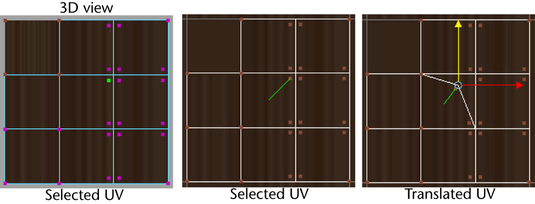Draw only what is facing the camera in the 3D view in the wireframe mode. You can improve performance on some systems by turning
on . Select one of the following options:
- Off
-
By default, Maya turns backface culling off. All wireframes are shown.
- On
-
Surfaces appear invisible in areas where the normal points away from the camera.
Select one of the following culling options.
-
-
Displays wireframe outlines.
-
-
Sets backface culling for soft edges only.
-
-
-
-
Show vertex points on the selected polygons.
-
-
Adjusts the size that vertices are drawn in the scene view. The default size is 3. The range is from 0.2 to 10.
-
-
Show UV texture coordinates (UVs) on the selected polygons.
-
-
Show the UV texture coordinates (UVs) on your object.
If UVs are shared, they display as single purple dots.
If the UVs are not shared, multiple purple dots display close to the vertex to which a given UV belongs. When you select the
UV in the , a line displays pointing to the face it belongs to.
Turn on the option to display and be able to select unshared UVs.
-
-
Adjusts the size that UV texture coordinates (UVs) are drawn in the scene view and the . The default size is 4. The range is from 0.2 to 10.
-
-
Display index numbers on an object’s vertices, edges, faces or UVs, depending on which component types you select. The numbers
for UVs only appear in the .
-
-
Show perpendicular lines (normals) of each face of the polygon.
-
-
Show perpendicular lines (normals) of each vertex of the polygon. Vertex normals only appear on selected objects.
-
-
Displays lines on the mesh indicating the tangent and binormal directions. Binormals appear in a blue color. Tangent normals
appear in a red color.
-
-
Adjust the length of the normals by entering a value or using the slider to specify a size. The range is from 0.2 to 10.
-
-
Display all edges in default settings.
-
-
Show dotted lines as soft edges and solid lines as hard edges.
-
-
Show only hard edges (soft edges are invisible).
-
-
Highlights all border edges (only in the ).
-
-
Turn on or off the crease edges on polygons.
-
-
Turn on or off the texture border edges.
-
-
Adjust edge width by entering a numeric value or using the slider to select ranges of 0.02 to 10.
-
-
Show a small square to indicate the face center.
-
-
Show all polygon faces as triangles.
-
-
Highlight all non-planar faces.
-
-
Restore default settings.
-
-
Limits the changes that you make to the selected polygons. To apply display changes to all polygons, turn off this option.
Using the window, you can set how specific components of your polygons display. This dialog box provides a way to set multiple options
also available in the menu, and compatibility with previous versions of Maya.
-
-
Determines the objects affected by the settings you apply in this window.
-
-
Allows you to display vertices and vertex normals on polygons.
Same effect as the and options respectively.
-
-
-
-
-
-
Allows you to customize the display of edge hardness.
Same effect as , and .
-
-
Allows you to highlight Border edges, Texture Edges and Crease edges.
Same effect as , and respectively.
-
-
-
-
Allows you to display face centers, face normals and non-planar faces.
Same effect as , and respectively.
-
-
Allows you to display the ID for each vertex, edge, face and UV.
Same effect as the options in .
-
-
Adjusts the length of normals when they are displayed.
Same effect as.
-
-
Adjusts the size of UVs.
Same effect as .
-
-
Allows you to display UVs individually or as a topology on objects at all times.
Same effect as and respectively.
-
-
When is on, you can see the effects of , , and the while in shaded mode. This option is turned on by default whenever you select these commands. Select a to refine your application. See Coloring polygons for details about using these options and the operation.
-
-
Allows you to quickly see what meshes will look like when they are smoothed.
Same effect as pressing 2 on your keyboard.
-
-
Allows you to display both the original mesh (as a cage) and the smooth mesh at the same time, or just the smooth mesh.
-
-
Allows you to choose whether you want to edit the original version, the smoothed version, or both versions of your mesh simultaneously.
Only available when is set to .
-
-
Determines the number of concurrent smooth operations shown in the scene panel.
A number of extra options for . For more information on these controls, see Mesh > Smooth.
